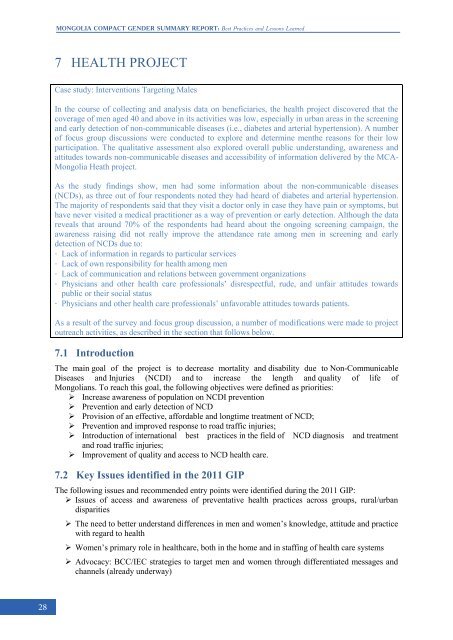Ulaanbaatar 2013
Ulaanbaatar 2013
Ulaanbaatar 2013
Create successful ePaper yourself
Turn your PDF publications into a flip-book with our unique Google optimized e-Paper software.
Mongolia Compact Gender Summary Report: Best Practices And Lessons Learned7 HEALTH PROJECTCase study: Interventions Targeting MalesIn the course of collecting and analysis data on beneficiaries, the health project discovered that thecoverage of men aged 40 and above in its activities was low, especially in urban areas in the screeningand early detection of non-communicable diseases (i.e., diabetes and arterial hypertension). A numberof focus group discussions were conducted to explore and determine menthe reasons for their lowparticipation. The qualitative assessment also explored overall public understanding, awareness andattitudes towards non-communicable diseases and accessibility of information delivered by the MCA-Mongolia Heath project.As the study findings show, men had some information about the non-communicable diseases(NCDs), as three out of four respondents noted they had heard of diabetes and arterial hypertension.The majority of respondents said that they visit a doctor only in case they have pain or symptoms, buthave never visited a medical practitioner as a way of prevention or early detection. Although the datareveals that around 70% of the respondents had heard about the ongoing screening campaign, theawareness raising did not really improve the attendance rate among men in screening and earlydetection of NCDs due to:‐ Lack of information in regards to particular services‐ Lack of own responsibility for health among men‐ Lack of communication and relations between government organizations‐ Physicians and other health care professionals‟ disrespectful, rude, and unfair attitudes towardspublic or their social status‐ Physicians and other health care professionals‟ unfavorable attitudes towards patients.As a result of the survey and focus group discussion, a number of modifications were made to projectoutreach activities, as described in the section that follows below.7.1 IntroductionThe main goal of the project is to decrease mortality and disability due to Non-CommunicableDiseases and Injuries (NCDI) and to increase the length and quality of life ofMongolians. To reach this goal, the following objectives were defined as priorities:‣ Increase awareness of population on NCDI prevention‣ Prevention and early detection of NCD‣ Provision of an effective, affordable and longtime treatment of NCD;‣ Prevention and improved response to road traffic injuries;‣ Introduction of international best practices in the field of NCD diagnosis and treatmentand road traffic injuries;‣ Improvement of quality and access to NCD health care.7.2 Key Issues identified in the 2011 GIPThe following issues and recommended entry points were identified during the 2011 GIP:‣ Issues of access and awareness of preventative health practices across groups, rural/urbandisparities‣ The need to better understand differences in men and women‟s knowledge, attitude and practicewith regard to health‣ Women‟s primary role in healthcare, both in the home and in staffing of health care systems‣ Advocacy: BCC/IEC strategies to target men and women through differentiated messages andchannels (already underway)28Page 28 of 80


